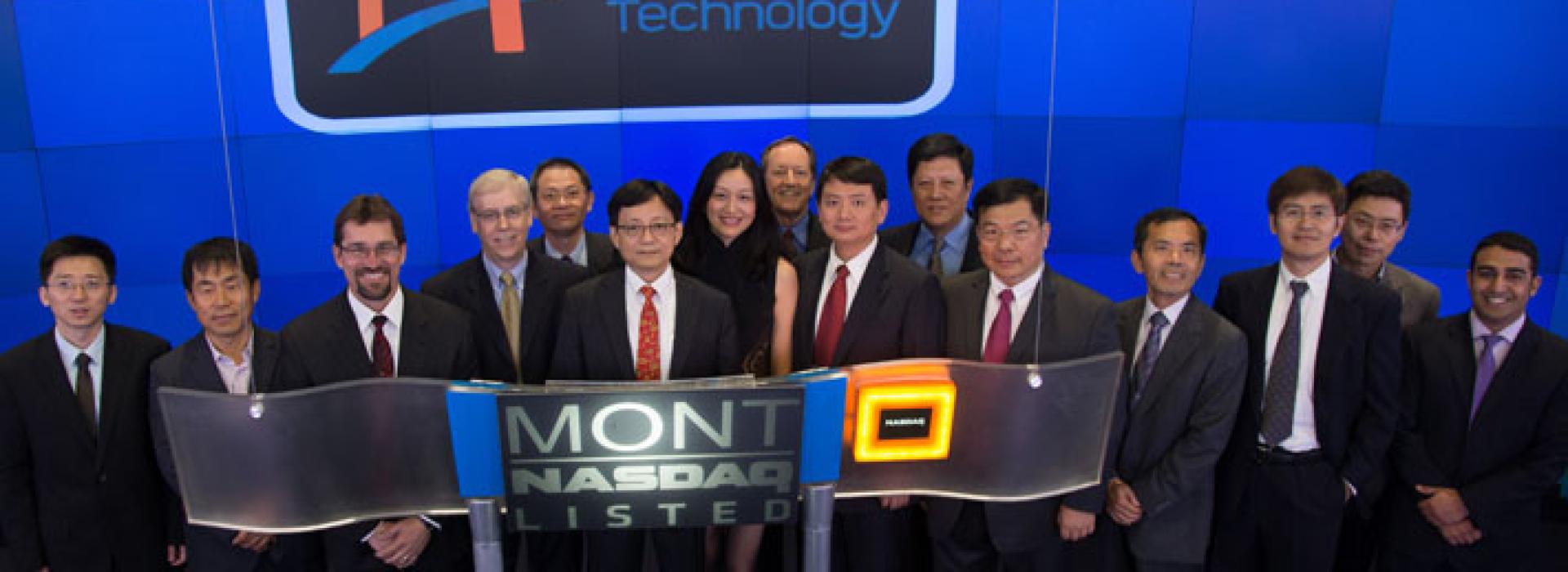Howard Yang (center) and colleagues at the initial public offering of Montage Technology on the Nasdaq Global Market in September 2013.
Howard Yang was the first integrated-circuits (IC) designer to return to China from Silicon Valley and help lead the high-tech transformation there starting in the early 1990s through education and entrepreneurship. At a time when mixed-signal design was unknown in China, he taught engineers and graduate students at Fudan University in Shanghai, and co-founded the first IC design company in China.
Yang credits the strong courses at Oregon State University for building the foundation of his knowledge. Additionally, he says, Dave Allstot was a “wonderful advisor” who went beyond the academic training to help him learn about business and fine tune the presentation of his work — lessons he still benefits from today.
When Yang arrived in the U.S. from China for graduate school in 1983, he entered a different world.
“China was just starting to reform and was a typical developing country so there were many big differences. For example, China did not have a freeway at that time and most people didn’t have cars — they rode bicycles,” he says.
The change in culture was not difficult he says, but it was definitely an adjustment, recalling he had to ask fellow students for help on how to use a vending machine. Just 11 years later, the combination of his skill and business acumen put him at the forefront of the high-tech revolution in China.
“Howard has an incredible business sense,” Allstot says. “Every time there is a fork in the road, his natural instincts kick in and he makes the right decision.”
After graduate school, Yang spent a few years in Silicon Valley, and in 1994 decided to go against popular wisdom and return to China to start his own company.
“Silicon Valley was in its golden time so most of the people thought I should stay there, but I took a different approach,” Yang says. It turned out to be one of those forks that Allstot was talking about.
“I could foresee the opportunity of China’s rising high-tech industry,” Yang says.
He took a bit of Allstot’s legacy with him to China. While a Ph.D. student at University of California, Berkeley, Allstot and another student developed a telecommunications chip to translate analog voice signals into digital for National Semiconductor.
“That chip was a classic, and 20 years later I had the idea to update it for China,” Yang says.
In 1997 he co-founded Newave Semiconductor Corp. The company was a milestone for China, making venture capital a new way to do business there. Newave became so successful that it caught the attention of Silicon Valley, and Integrated Device Technology Inc. acquired the company for $85 million. It was ranked as one of the top ten mergers by Chinese Merger and Acquisitions Yearbook in 2002.
Despite the amazing success of Newave, Yang does not see it as the pinnacle of his career, and is working hard to grow his new business, Montage Technology, into an important semiconductor design house. He is well on his way with a successful initial public offering last September, trading on the Nasdaq. Montage employs 450 people and has sold over 300 million chips for digital televisions and cloud computing.
“We will continue to focus on the two current areas for the next few years because those markets are still growing very quickly,” Yang says.
Business opportunities were not the only reason Yang decided to return to China. He wanted to be near his parents and sisters, but he also has a passion for Chinese classical art which was hard to study in Silicon Valley.
“I don’t play golf, so I spend my free time studying art history,” he says.
He describes his interest in art as “more serious than a normal hobby.” Indeed, he has co-supervised graduate students in art history at the China Academy of Art and Nanjing Normal University and is currently working on a paper that analyzes the geometry of classical Chinese paintings — combining his dual interests in science and art.
From circuits, to business, to art, Yang is looking at the classics with a different vision.



